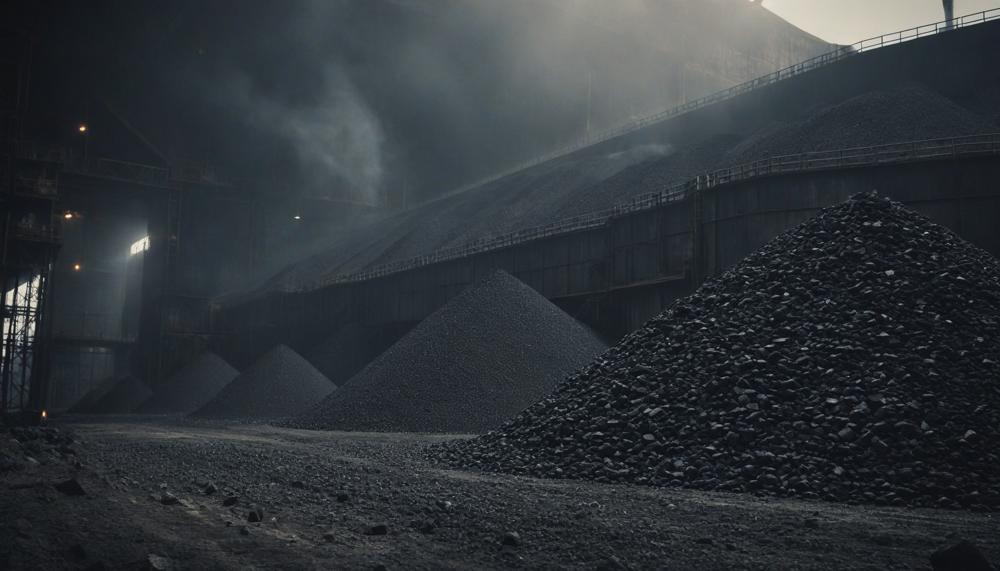Coal storage isn’t just about finding a place to stash your fuel; it’s a meticulous process that can significantly impact its usability and safety. How long can you store coal effectively? The answer lies in the storage conditions. Coal can last indefinitely if stored properly, but several factors can drastically shorten its lifespan.
Key Points to Consider:
- Susceptibility to Elements: Coal is highly vulnerable to moisture, air, and sunlight. These can lead to deterioration, spoilage, and loss of combustibility.
- Health and Safety Risks: Improperly stored coal can pose serious health risks such as respiratory issues and safety hazards like fires and explosions.
- Storage Techniques:
- Indoor Options: Coal rooms, closets, basements, or utility rooms are ideal.
- Outdoor Solutions: Require robust protection against moisture.
- Choosing Containers: Factors like size, capacity, durability, sealing, and ventilation are crucial.
- Long-term Storage Tips:
- Keep coal dry.
- Rotate stock using a FIFO (First In, First Out) system.
- Regularly inspect for signs of deterioration.
- Avoid sunlight exposure.
- Monitor for pests.
- Minimize dust accumulation through regular cleaning.
- Maintenance: Regularly monitor moisture levels using meters or sensors to ensure a safe environment.
By adhering to these storage practices, you can maintain coal’s longevity and usability, ensuring it’s ready whenever you need it. Proper coal storage not only safeguards your fuel supply but also protects your health and safety. Dive into the detailed strategies and tips to make the most of your coal storage and avoid common pitfalls.
Contents
- 1 How Long Can You Store Coal?
- 2 Factors Affecting the Longevity of Stored Coal
- 3 Best Practices for Indoor Coal Storage to Maximize Lifespan
- 4 Outdoor Coal Storage Solutions and Protection Against Deterioration
- 5 Monitoring and Maintenance Techniques for Ensuring Long-Term Coal Storage
- 6 Signs of Deterioration to Watch Out for in Stored Coal
- 7 Safety Measures to Prevent Hazards When Storing Coal Long-Term
- 8 Conclusion
How Long Can You Store Coal?
| Storage Method | Storage Duration | Additional Tips |
|---|---|---|
| Indoor Storage (Dry, Ventilated) | Indefinitely | Ensure proper ventilation and moisture control. |
| Outdoor Storage (Covered, Dry) | Several months to years | Protect from moisture and direct sunlight. |
| Properly Managed Stockpile | Years | Rotate using FIFO system, monitor for deterioration. |
Coal storage duration varies based on storage conditions and management practices. Indoors, where it’s dry and well-ventilated, coal can be stored indefinitely. Outdoors, in covered, dry environments, it can last several months to years.
Proper management, including rotation and regular inspection for signs of spoilage, can extend storage duration for years. Monitoring moisture levels and cleanliness are critical to prevent degradation and ensure safety.
Factors Affecting the Longevity of Stored Coal
| Factors | Impact on Longevity of Stored Coal |
|---|---|
| Moisture Content | High moisture levels promote fungal growth, self-heating, and deterioration. |
| Temperature | Higher temperatures accelerate chemical reactions leading to degradation. |
| Oxygen Exposure | Exposure to oxygen causes oxidation reactions, decreasing heating value. |
| Coal Type and Quality | Varying susceptibilities to degradation based on inherent properties. |
| Storage Conditions | Proper ventilation, protection from precipitation, and sunlight exposure are crucial. |
| Handling Practices | Careless handling increases breakage, dustiness, and potential loss of combustible material. |
Moisture content is critical as it can lead to fungal growth and self-heating in stored coal. Temperature affects storage longevity by accelerating degradation processes. Oxygen exposure causes oxidation reactions, decreasing coal quality.
Different coal types vary in their susceptibility to degradation. Proper storage conditions include ventilation and protection from elements. Careful handling practices minimize breakage and dustiness, preserving coal quality.
Best Practices for Indoor Coal Storage to Maximize Lifespan
The key to prolonging the lifespan of indoor coal storage lies in meticulous handling and optimal storage conditions. Below are essential best practices:
| Factor | Best Practice | Explanation |
| Moisture Control | Use moisture barriers | Prevent moisture ingress which can accelerate deterioration. |
| Temperature Regulation | Maintain cool temperatures | Avoid heat buildup that can lead to spontaneous combustion. |
| Oxygen Exposure | Minimize exposure | Reduce oxidation processes that degrade coal quality. |
| Coal Type | Segregate by type | Store different coal types separately to maintain quality. |
| Storage Conditions | Use airtight containers | Protect coal from environmental contaminants and dust. |
| Handling Practices | Gentle handling | Avoid breakage and fines generation during transport and storage. |
Implementing these practices ensures that coal retains its calorific value and burns efficiently over time. By controlling moisture, temperature, and exposure to oxygen, and by employing suitable storage containers and handling techniques, you can significantly extend the lifespan of your indoor coal storage while maintaining optimal quality for combustion.

Outdoor Coal Storage Solutions and Protection Against Deterioration
Outdoor coal storage requires robust solutions that prevent deterioration from moisture, oxygen, and varying weather conditions. The best options are as follows:
- Coal Bunkers: Coal bunkers, made from hard plastic or galvanized steel, are prime for outdoor coal storage. Their durability and resistance to weather make them excellent at keeping coal dry and well-preserved. Typically easy to assemble, these bunkers can be situated discreetly around the house, such as in backyards or side spaces, without clashing with garden aesthetics.
- Repurposed Storage Chests/Baskets: For a more personalized touch, repurposing old storage chests or baskets for coal storage is a practical choice. These can hold a substantial quantity of coal and can be painted or decorated to complement outdoor living spaces, offering both functionality and style.
Both methods protect coal from environmental elements and ensure it remains dry and in good condition for effective use. Below is a table outlining the key characteristics of each storage solution:
| Storage Type | Material | Benefits |
| Coal Bunkers | Hard Plastic / Galvanized Steel | Durable, weather-resistant, easy to assemble, does not disrupt garden aesthetics |
| Repurposed Storage Chests/Baskets | Varied (usually wood or metal) | Customizable, blends with the environment, substantial storage capacity |
Monitoring and Maintenance Techniques for Ensuring Long-Term Coal Storage
Monitoring and maintaining long-term coal storage involves several critical practices to ensure the coal’s quality and safety. These techniques focus on controlling environmental factors, conducting regular assessments, and preventing deterioration or hazards.
- Temperature Control: Keeping the temperature within a specific range prevents moisture build-up, which can lead to coal degradation or spontaneous combustion.
- Moisture Management: Effective moisture control is achieved through adequate ventilation, use of moisture-absorbing materials, and periodic moisture checks to prevent mold and self-heating of coal.
- Quality Testing: Routine analysis of the coal’s calorific value, ash content, sulfur content, and particle size ensures the coal remains suitable for its intended use and identifies any degrading changes early.
- Pest Control: Protecting the coal from pests like rodents and insects prevents contamination and maintains the coal’s integrity. This involves sealing potential entry points and using traps or insecticides.
- Regular Inspection: Inspections are crucial for identifying early signs of degradation, structural issues, or environmental impacts that could compromise the storage conditions.
- Handling Practices: Proper handling during the transportation, loading, and unloading of coal minimizes physical damage and helps maintain uniformity in the coal’s quality.
Signs of Deterioration to Watch Out for in Stored Coal
| Signs of Deterioration | Description | Action Required |
|---|---|---|
| Moisture Content | High moisture levels leading to dampness, mold, and reduced calorific value. | Ensure proper ventilation and moisture control. |
| Odor | Musty or sour smell indicating microbial activity and decreased heating efficiency. | Investigate and improve ventilation; consider quality testing. |
| Discoloration | Darkening or yellowing due to oxidation, reducing energy content. | Monitor and prevent exposure to air; quality assessment. |
| Formation of Lumps | Clumping or hard lumps from caking, making coal handling difficult. | Break lumps apart for easier handling; improve moisture control. |
| Presence of Fungal Growth | Visible fungi indicating excessive moisture and poor ventilation. | Address moisture issues; consider fungicide if necessary. |
| Dustiness | Increased dust formation making coal handling and transport challenging. | Minimize dust generation through proper handling and storage. |
| Heat Generation | Elevated temperatures from self-heating, risking spontaneous combustion. | Regularly monitor temperatures and ventilate storage areas. |
By staying alert to these signs of deterioration in stored coal, individuals can effectively manage risks and maintain the quality of their coal over extended periods.
Safety Measures to Prevent Hazards When Storing Coal Long-Term
| Safety Measure | Description |
| Proper Ventilation | Adequate airflow prevents dangerous gases like carbon monoxide from accumulating, reducing the risk of combustion. |
| Moisture Control | Prevent spontaneous combustion by covering stockpiles with waterproof materials and ensuring proper drainage. |
| Fire Prevention | Install fire detection systems, conduct regular inspections for hot spots, and maintain clean storage areas to mitigate fire risks. |
| Structural Integrity | Regular inspections and maintenance ensure storage facilities are stable, preventing accidents and collapses. |
| Segregation of Materials | Organize coal by type to avoid contamination and manage risks associated with different coal properties. |
| Training and Education | Train personnel on safety procedures, hazard awareness, and emergency response to promote a safe working environment. |
| Emergency Preparedness | Develop and practice emergency plans, ensuring access to firefighting equipment and swift response to incidents. |
These safety measures are crucial for long-term coal storage to prevent hazards such as combustion, contamination, and structural failures.
Conclusion
Coal, if regarded as a resource in a chest of time-honored energy, retains its vigor and utility across a remarkable expanse of time when shielded with care. Its longevity hinges on the sanctuary provided by optimal storage conditions—each grain of coal can indeed last indefinitely under vigilant, indoor custody where moisture and ventilation are meticulously managed. Yet, the journey of outdoor storage, although robust, might be limited to mere months or extend to years depending on its shield against moisture and sunlight.
Mastering the art of coal storage means embracing practices that are akin to safeguarding a timeless artifact. For indoor realms, adopting air-tight containers, controlling the ambient temperature, and minimizing oxygen exposure ensures the coal’s essence remains unscathed from the claws of degradation. Outdoors, coal bunkers and inventive repurposing of storages create a fortress that defies weather’s whims.
This narrative isn’t just about storing an ancient rock; it’s about preserving an asset that fuels industries and warms homes. With coal, every preventive step against moisture, careful rotation of stock, and vigilant inspections for any signs of wear or hazard ensures that the black diamonds are ready to unleash their stored energy efficiently and safely, whenever called upon.






